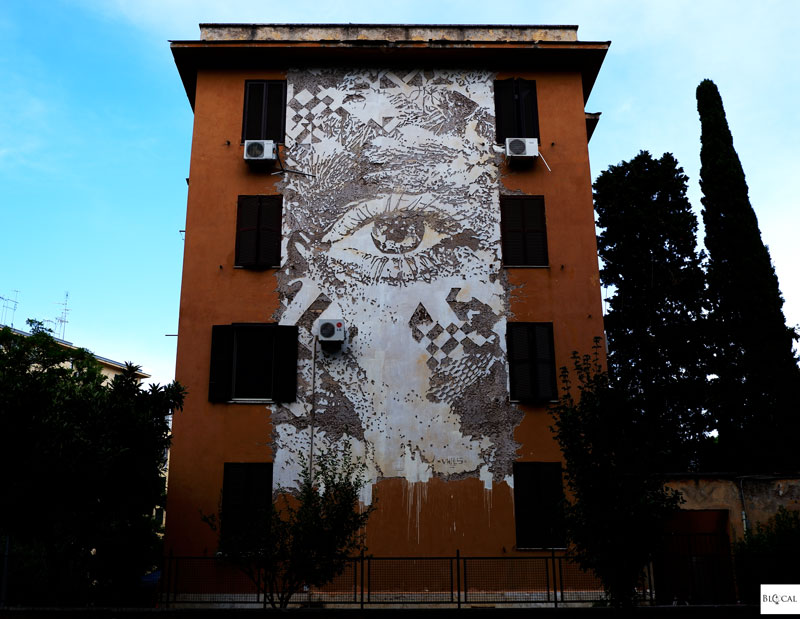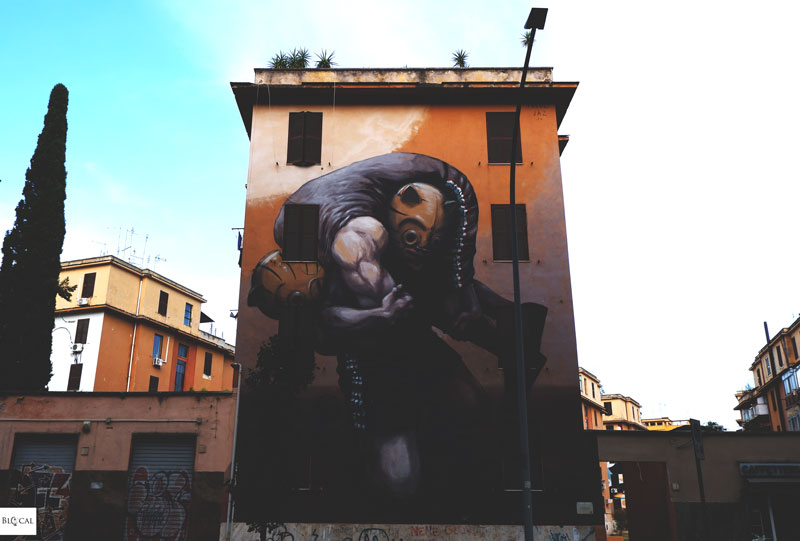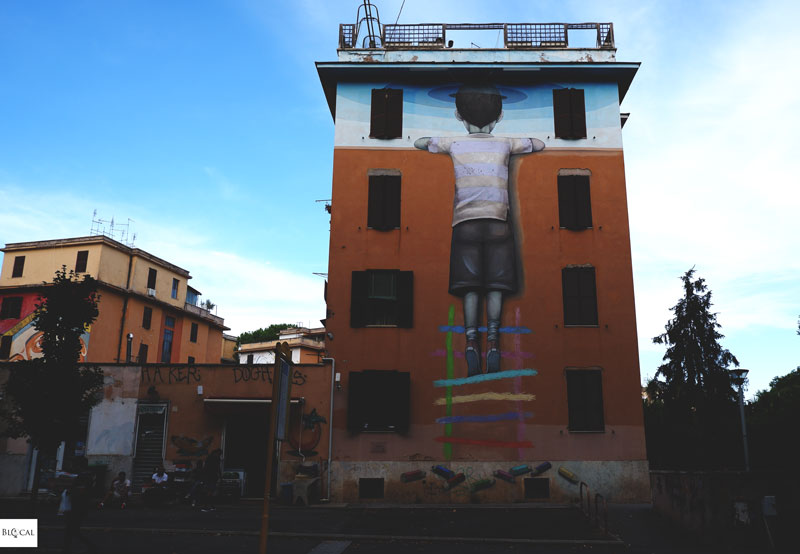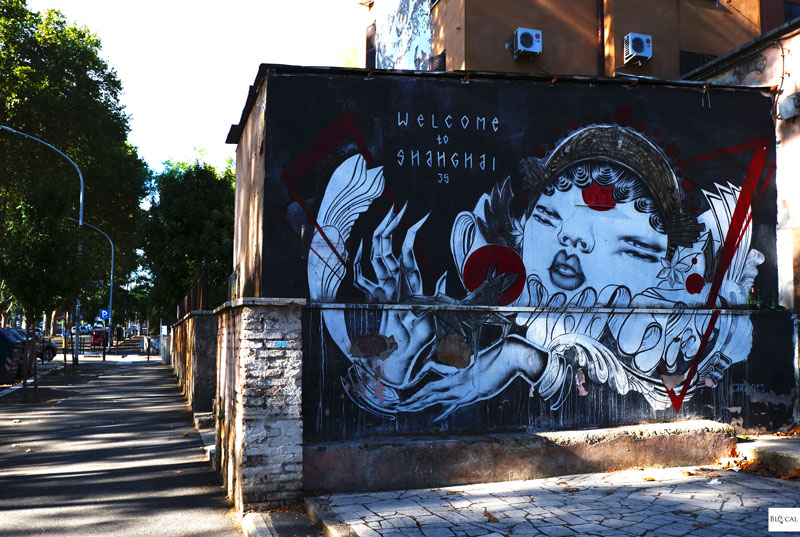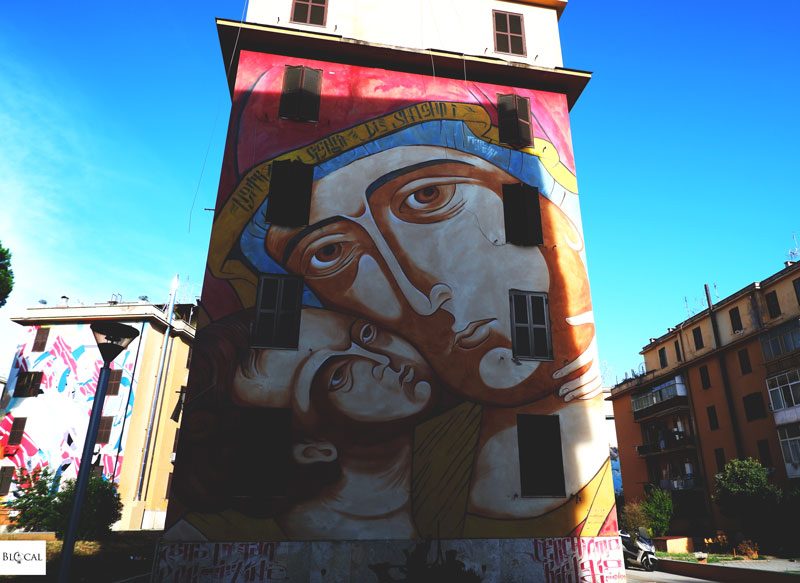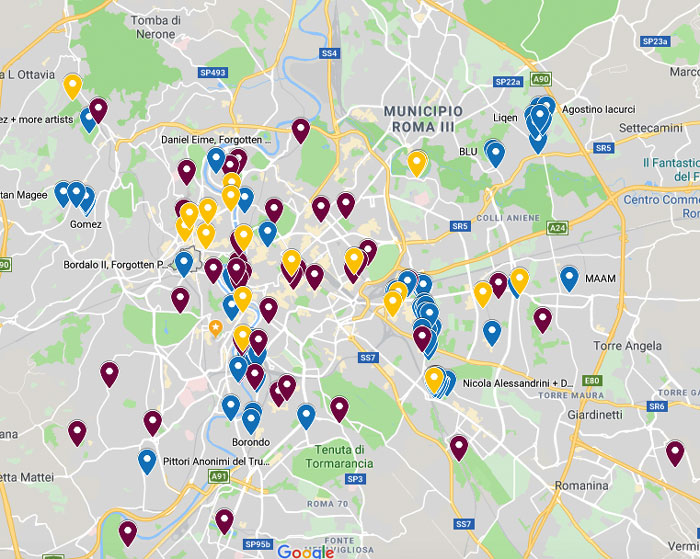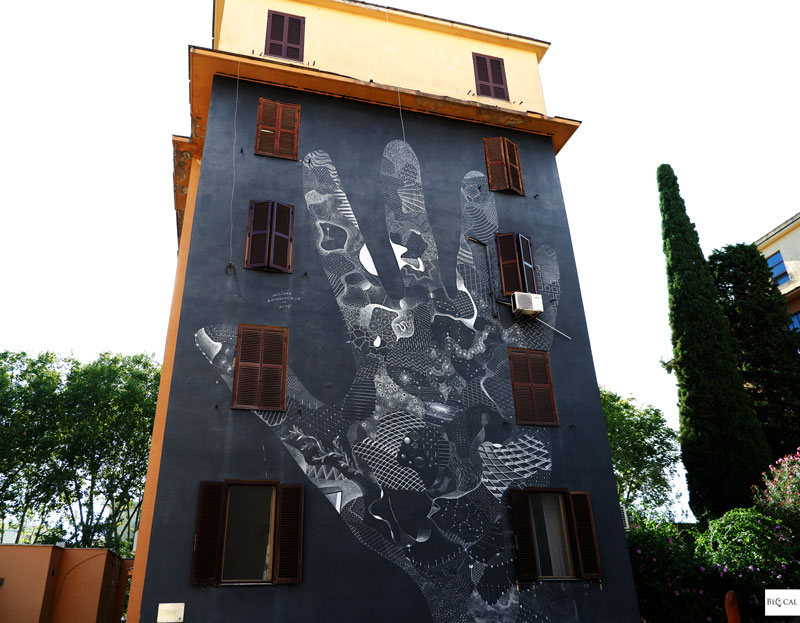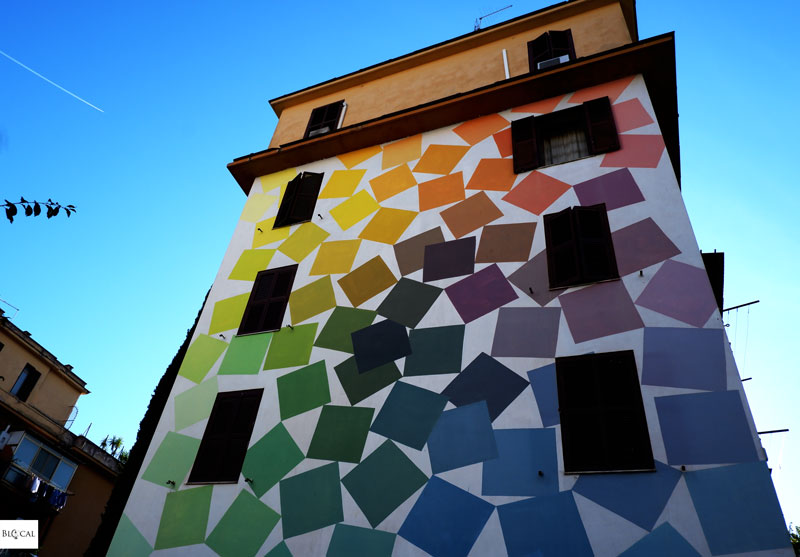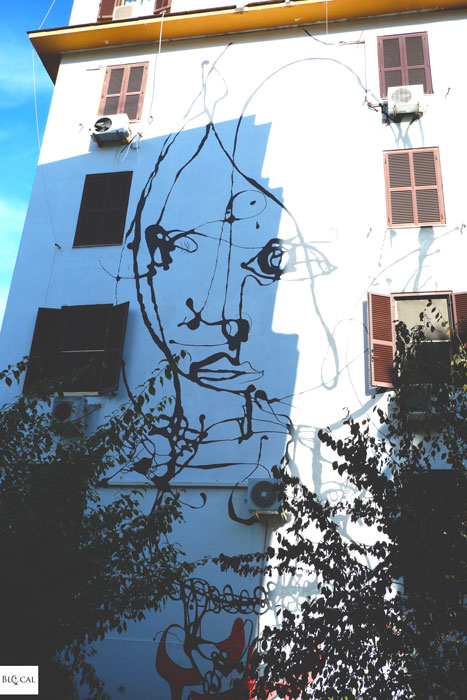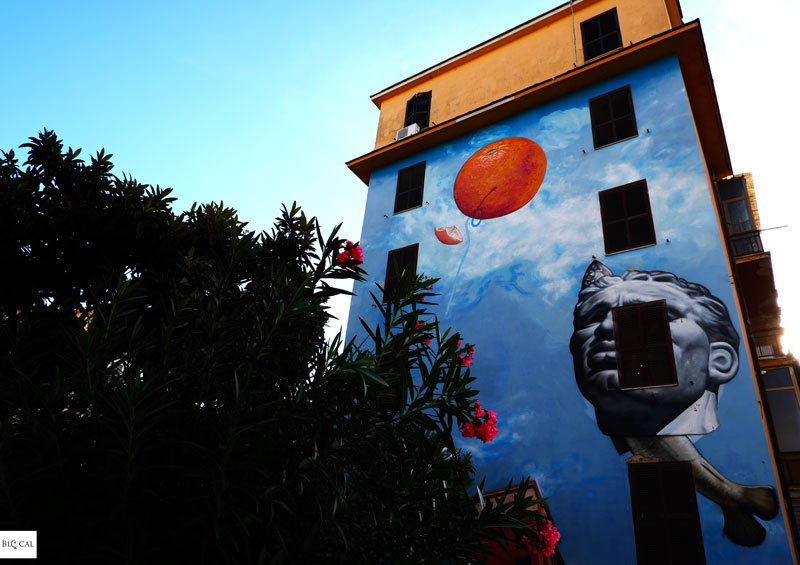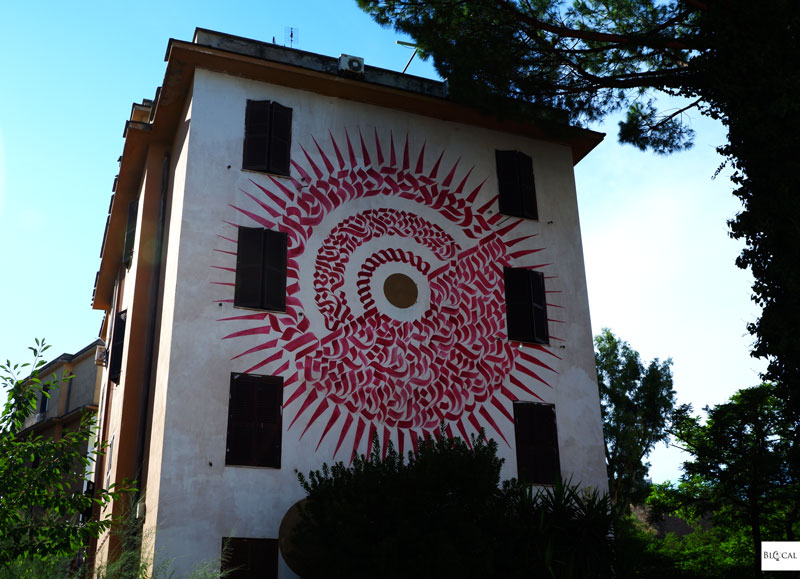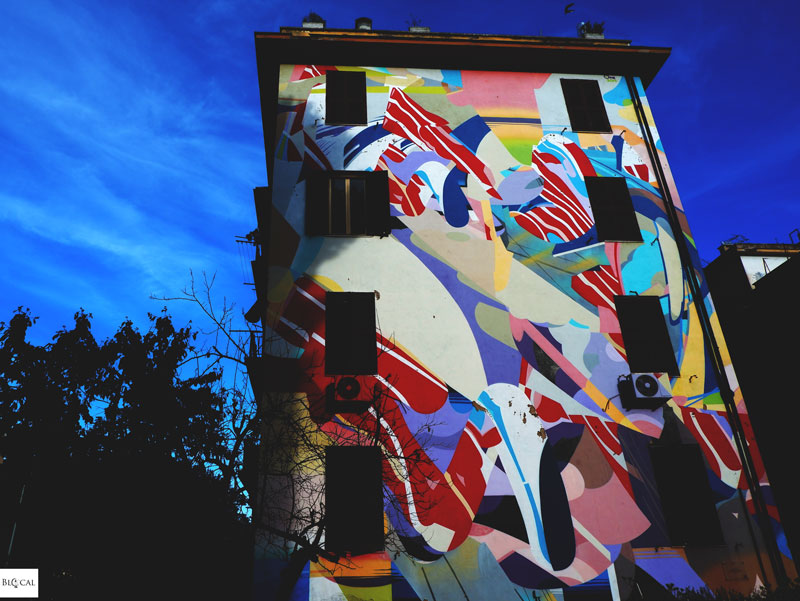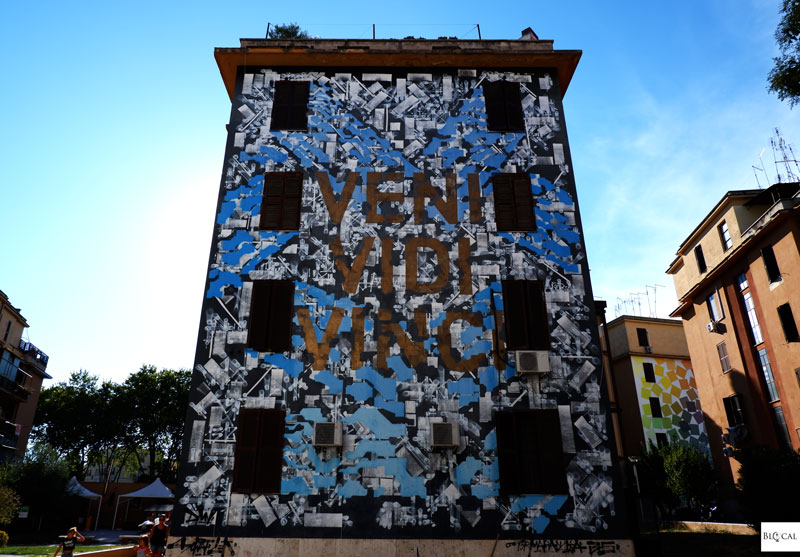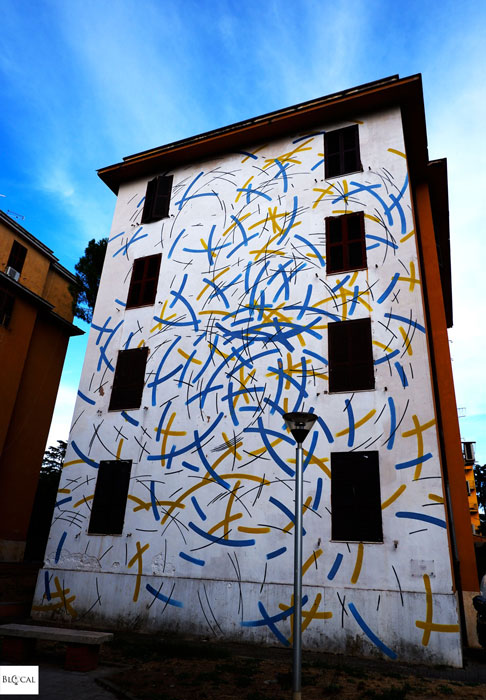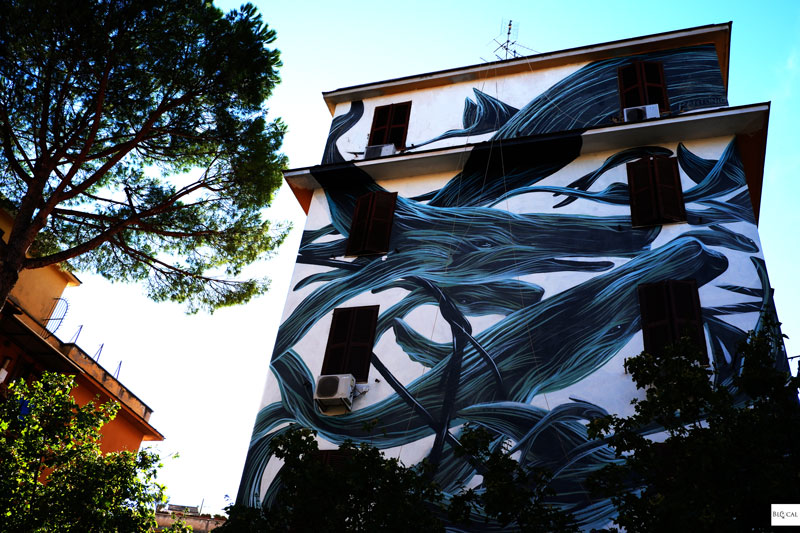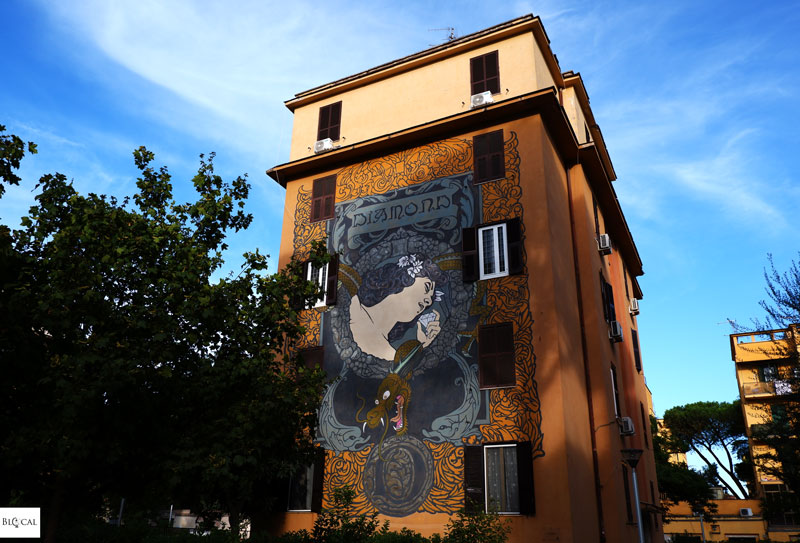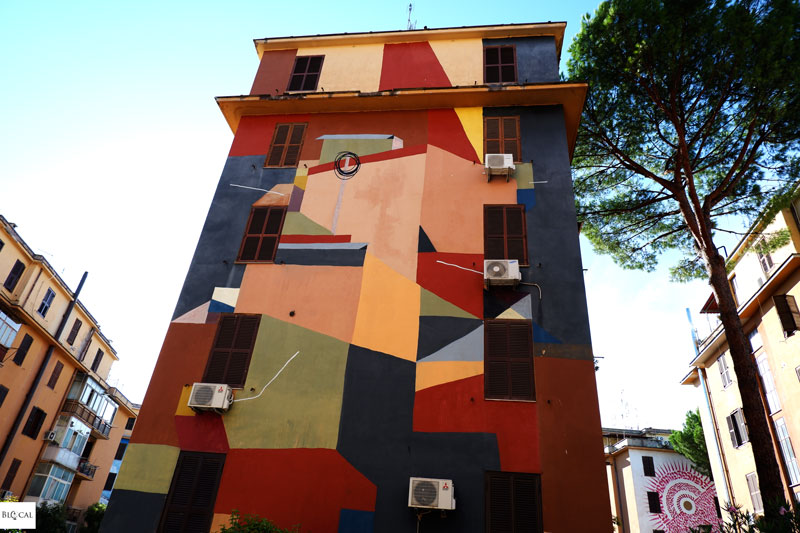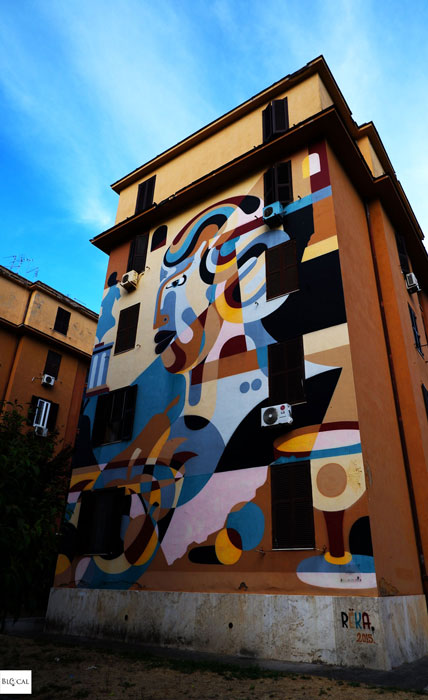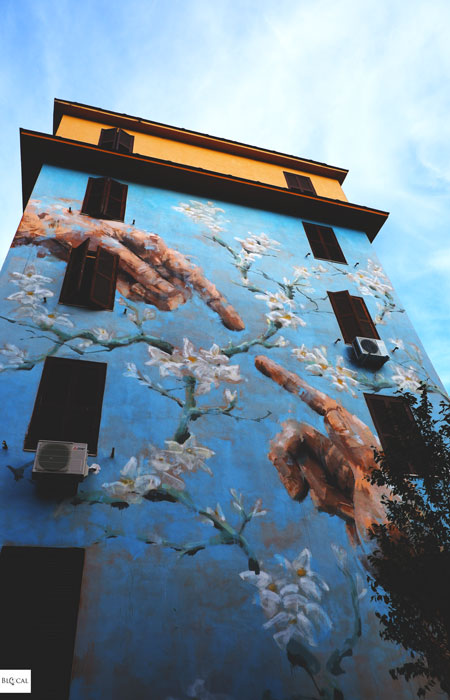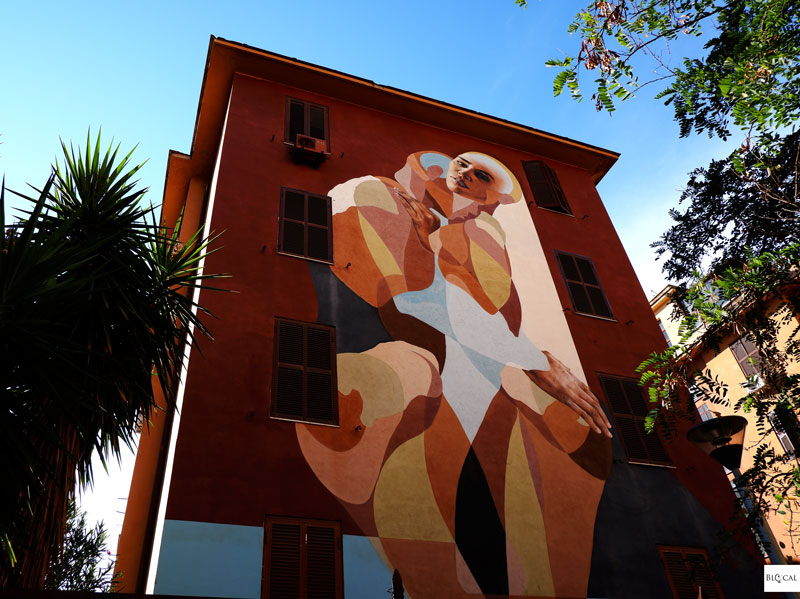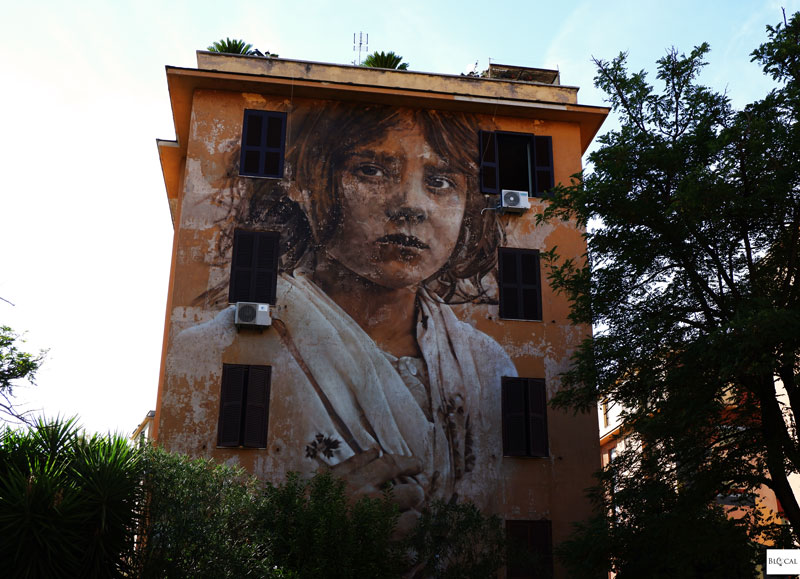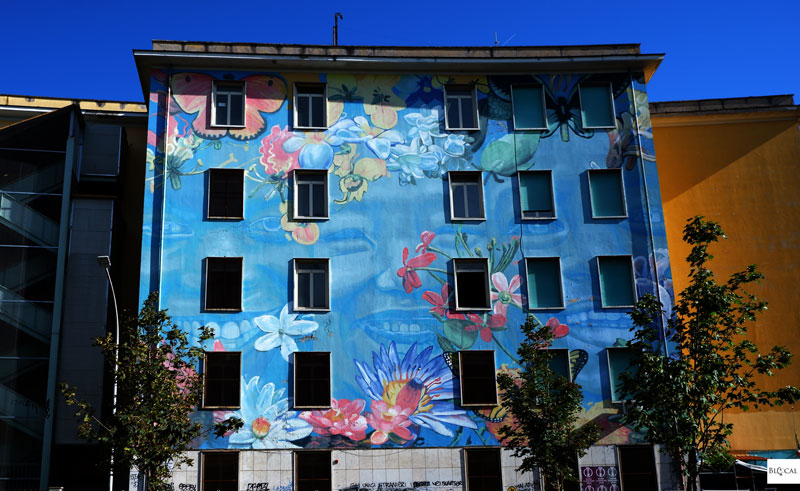You’ve probably already seen Tor Marancia Murals in countless movies and TV shows, and on this blog too. You might have even visited this public housing complex while hunting for the best street art in Rome, but perhaps you still don’t know the story behind the murals in Rome’s Tor Marancia neighborhood. If so, come with me to learn about the most photographed street art project in Rome: Big City Life.
Street Art Rome: Tor Marancia Murals
Arriving from Viale Tor Marancia, four beautiful murals welcome us to the most colorful public housing complex in Rome (although competing with the Trullo neighborhood for the title). The first mural in sight is an eye carved into the wall by Alexandre Farto, aka Vhils. The Portuguese artist developed his street practice by working with what was already there (as opposed to adding something to the wall), i.e. drilling his iconic portraits into the facade of the building to eternalize everyday people on walls. Carved in 2015, this is actually one of the last murals created for the Big City Life project.
- Read also: “Street Art in Rome: A Guide to Ephemeral Art in Italy’s Eternal City” the ultimate travel guide to the top 26 neighborhoods to find street art in Rome, with handpicked local tips to eat, drink and shop in Rome like a local.
Up next is an energetic mural by Francesco Fasoli, aka JAZ, who represented the solidarity and the strong bond between his country, Argentina, and Italy through the image of a match of lucha libre. The two fighters wear a tiger mask and shorts painted in national flag colors. Made in 2014, “Il Peso Della Storia” (“The Weight of History”) is the mural that inaugurated Rome’s street art project Big City Life.
Next to it we find “Bambino Redentore” (“Redeemer Child,” 2015), one of the iconic children painted by French street artist Seth all around the world. In Tor Marancia, Seth’s character pays homage to Luca, a local child who died after having an accident while playing football with his friends.
Before entering Tor Marancia’s public housing complex, there is one last wall to admire. It depicts a traditional mask from Chinese opera, a four-eyed girl holding in her hands the symbol of Rome: the she-wolf, made in origami paper. Here in Tor Marancia, Caratoes (a Belgian street artist who traced her Chinese roots by living in Hong Kong) re-proposed a sentence that was already written on that same wall: “Welcome to Shanghai 35.” The number 35 comes from Rome’s tombola (a board game similar to bingo, originally from Naples, but we do have our own version in Rome). In this game, the number 35 stands for “the madhouse” – the byname that residents chose for their colorful corner of Rome.
Yet another reference to Shanghai was painted on the walls of Tor Marancia by Rome-based street artist Mr. Klevra, whose body of work is inspired by religious iconography and Byzantine art. Fun fact: the mural “Nostra Signora di Shanghai” (“Our Lady of Shanghai,” 2015) was blessed by the parish priest of the local community. That might just be a first in the street art world ;)
Stepping into the public housing complex, we discover a peaceful courtyard with tiny gardens and huge murals. The area is strictly pedestrian, thus children play freely and residents of all ages sit down in groups, chatting, laughing, and paying zero attention to all of us roaming around to take pictures and record an Instagram reel.
Here is the reel I posted on my travel account:
Street Art in Rome: Tor Marancia neighborhood
Find Tor Marancia murals in my Rome travel and street art map, where I also pinned my favorite restaurants and cafés, independent shops, parks, hidden gems, and all cool places I love in my hometown. No touristy spots, only places where me and my friends usually go :)
One of the first murals close to the entrance of Tor Marancia public housing is the one made by Philippe Baudeloque. The French street artist painted “Elisabetta” (2015): a big hand containing the whole world in it, and beyond, up to the stars and constellations. The mural is named after a woman living in that same building, who offered her own hand as a model for the sketch.
Next to it, we find a beautiful abstract mural by Italian street artist Alberonero. The mural, “A Carlo Alberto 93 Colori” (“To Carlo Alberto 93 Colors,” 2015), is one of Alberonero’s optical compositions that draws inspiration from minimalism and the interpretation of the emotions generated by colors in a specific urban context based on the repetition of geometric shapes and chromatic variations.
Just opposite to it, local street artist Danilo Bucchi painted a stylized woman with red shoes. This minimalist mural made of black lines on a white background is titled “Assolo” (“Solo,” 2015).
Still at this side of the courtyard, there is a mural by Italo-American artist Andrew Pisacane, aka Gaia. Gaia named his mural in Tor Marancia with the first three words spoken by residents to describe the artwork: “Spettacolo, Rinnovamento, Maturità” (“Performance, Renewal, Maturity,” 2015). Gaia’s research narrates the historical, anthropological, and social contexts in which he paints his murals; hence, the ubiquitous reference to Giorgio De Chirico and his metaphysical compositions whenever Gaia paints in Italy (there is a mural by Gaia with a very metaphysical composition in the nearby San Paolo neighborhood). Next to the Giorgio De Chirico reference, we find a mandarine, which residents call ‘the orange’ (orange, arancia in Italian, makes indeed more sense for the association with the name of the area: Tor Marancia).
Venturing further into the courtyard, we find “Alme Sol Invictus” (2015) by Italian street artist Domenico Romeo: a big, red sun (the “Sol Invictus” mentioned in the title, aka Helios, the Sun God of the Roman Empire) painted in Domenico Romeo’s characteristic calligraffiti style. On top of the religious reference to ancient Romans’ pagan gods, Domenico Romeo invites residents to dive into their own spirituality in order to rebirth.
Do you want a personalised travel itinerary based on your interests and passions?
Then check out my concierge service ;)
Opposite to it is a mural by German street artist SatOne. “Talking Like a Waterfall” (2015) is a visual representation of the auditory sensations he experienced in Rome. I’ve never thought of it, but the image of a waterfall of words for Italians’ lively conversations is perfect; I wish I came up with that!
Next to it, the French writer duo Lek & Sowat painted “Veni, Vidi, Vinci.” This is not a typo, but an intended twist of Giulio Cesare’s famous sentence to tribute another notable Italian: Leonardo da Vinci.
In front of their mural, Italian street artist Moneyless painted one of his abstract artworks: “Il Vento” (The wind, 2015). The vortex in this Tor Marancia mural is a visual representation of the wind Ponentino.
The Roman wind Ponentino is also the subject of the mural by Portuguese street artist Pantonio (“Ponentino”, 2015). Pantonio is well-known for winding compositions of his iconic striped characters, which recall the strength of the black rocks and the sea of his homeland: the Azores islands.
Overlooking Pantonio’s dancing composition is “Hic Sunt Adamantes” (2015), the mural painted by Rome’s street artist Diamond stressing the fact that, prior to becoming Rome’s street art district, Tor Marancia was a very underrated area in the city. Ancient Romans used to write on maps “Hic Sunt Leones” (“Here Be Dragons”) to describe the areas that had not yet been explored. Diamond turned the popular sentence into Here Be Diamonds to highlight the great potential of the area. In this mural, Diamond painted in his iconic, Art Nouveau style a representation of Rome: a sleeping beauty unable to wake up from her numbness. And there is also a Shanghai reference: a Chinese dragon inside a golden garland that sparkles in the sunshine.
More street artists who painted in this area of the Tor Marancia courtyard are the German Clemens Behr and the Australian Reka, who depicted Romans’ proverbial hospitality in the cubism-inspired shape of a woman offering a tray of fruit.
At the end of the path, we find a mural by Jerico recalling the Sistine Chapel, in particular Michelangelo’s Creation of Adam, although here there is a flowering twig between the two fingers. Jerico’s mural for the Big City Life street art project is titled “Distanza Uomo Natura” (Man-nature distance, 2015).
Unfortunately, the paste-up portrait of Chinese artist Ai Weiwei realized by Roman photographer Matteo Basilé has eventually faded away, but on the outer road on the other side of Tor Marancia street art courtyard (Via di Santa Petronilla) we can still admire two more majestic murals.
One is by the English duo Best Ever, who in 2008 painted “The Pyramid,” a hug between a man and a woman. With her highly detailed, hyper-realistic countenance, the woman casts a tense gaze at passersby.
Next to it, Guido Van Helten painted “Io Sarò” (“I Will Be,” 2015). The Australia-based street artist worked on an old photo from Francesco Paolo Micheletti’s archive (among the first Italian artists to experiment with photography). The photo depicts a young girl with a sad gaze and a mesmerizing, helpless expression.
Bonus Track: One More Mural in Tor Marancia
Yet one more mural by Gaia, this time on the facade of the Art School in Viale Odescalchi (Liceo Caravaggio, just a short walk from Guido Van Helten’s mural). Titled “Uneven Humanism,” this flowery composition with a smiling child surrounded by colorful butterflies tells a less happy story about migration and inequity.
Rome Street Art Map:
Find Tor Marancia murals in my Rome travel and street art map, where I also pinned my favorite restaurants and cafés, independent shops, parks, hidden gems, and all cool places I love in my hometown. No touristy spots, only places where me and my friends usually go :)
